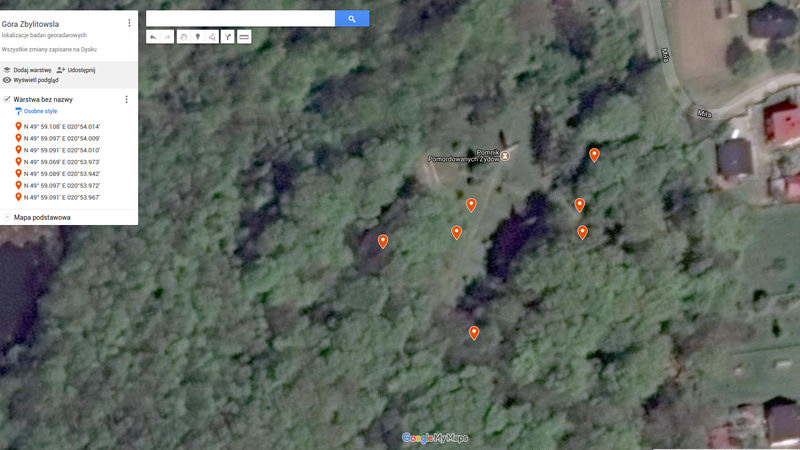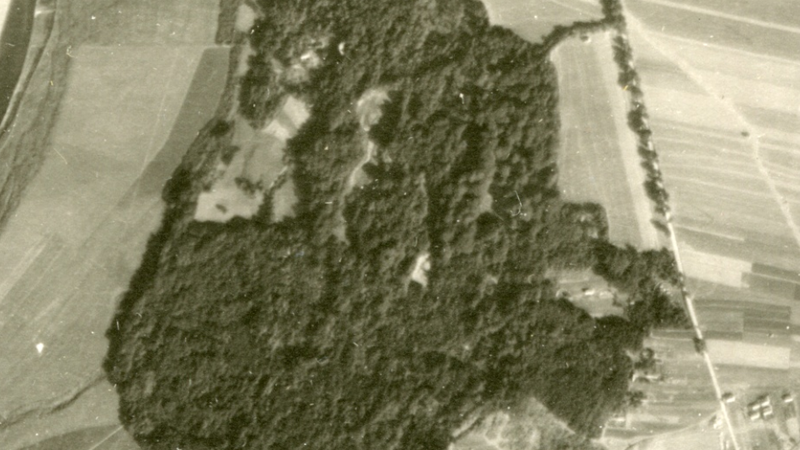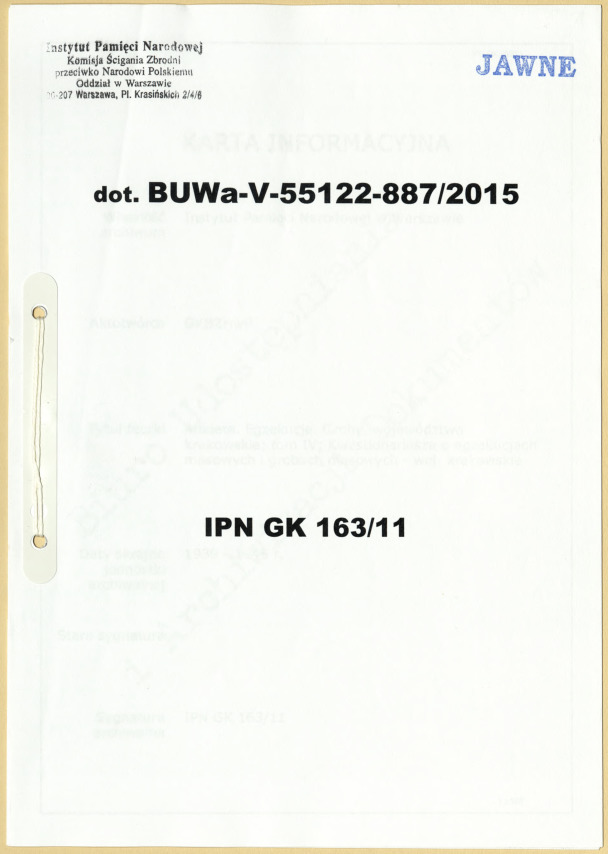Góra Zbylitowska
Borough of Tarnów, Tarnów District, Małopolskie VoivodshipType of place
The war cemetery in Góra Zbylitowska.Information about the crime
In 1942-44 the hamlet of Buczyna in the Zbylitowska Góra village became the place of execution and mass burials of approx. 6000 Jews from the ghetto in Tarnów, including 800 children from the ghetto orphanage as well as 2000 officers of the Polish Army and the Underground State activists. Some sources give the number of 10000 murdered people. According to the Questionnaire of mass executions and mass graves from September 1945, there are at least 6 graves of unknown dimensions (IPN Gk 163/11, p. 3 and 4). Meanwhile, in the case file no Ds. 1/70, vol. 22, p. 108 there is aninformation about a court report from a site inspection of mass graves carried out on 22 September 1945. The following graves were described: 2 graves with dimensions 3 metres by 12 metres, 2 graves with dimensions 3 metres by 16 metres, 1 grave with dimensions 3 metres by 22 metres, 2 graves with dimensions 3 metres by 30 metres and 1 grave with dimensions 55 steps by 54 steps. They were dug by forced labourers from Baudienst.
In August 2015 we recorded an account of Jan – one of the forced labourers, born in 1922: “In 1940, when they were shooting Jews, I was 20 years old. They were incorporating us by force to battalions [Baudienst – the Building Service of the General Government.] We did different things; in Tarnów they had barracks, we were going there to do drainage, we were also taken to the brickyard. One day on the way to work we noticed that they were evicting people in Tarnów, probably Jews. One day they took us from work at 11 am, gathered us on the Cathedral Square and placed in groups of three. We saw the whole square full of people squatting because they were not allowed to stand up. They were the expelled Jews. They ordered us to take the luggage that [the Jews] were carrying and put it in a pile. We thought they would be relocated. They were saying they had food in those bags, pleading with us not to take them. But it was an order and if someone didn’t want to give their bag, a German was hitting them in the head [so hard] that blood was splashing. Then the Jews were ushered down the stairs towards the school [probably the Tadeusz Czacki Primary School.] We went to the school with the luggage and saw a smoke coming out of the cellar and people screaming: ‘Water! Water!’ There was a well and crockery so I took some water and passed it through a window. What I achieved was to get kicked by a German who just came out and saw me passing the water. He kicked me and said if I did it again, he would shoot me. During the night they took half of us to the Jewish cemetery to bury the Jews who suffocated in that steam. It looked like steam.
A few days later they drove several of us in a car towards Zgłobice and turned right to Buczyna. And in Buczyna I saw a ditch; quite a few ditches were dug there. Long ditches: about 2 metres wide and up to 2 metres deep. Suddenly we heard a sound of incoming cars and we saw two lorries – one of them with people, the other with corpses. Firstly, they took the people and ushered them down the pathway. They took two of them at once, ushered them to the ditches and shot them. Two Jews came close [to the ditch], they were shot in the back of the head and fell straight into the ditch. If someone didn’t fall, they pushed them and shot again. Then they told us to take the corpses brought [by the other lorry] and carry them to the ditches. There was no access so they told us to drag them by the legs. At the ditch they told us to take the clothes that were clean and place them in a pile and bury the bodies in their underwear. Later they [ordered us] to cover [the ditch] with lime and soil.” (Zbylitowska Góra, 12 August 2015.)
IDENTIFICATION OF THE GRAVE BASED ON NON INVASIVE RESEARCH
On the 7th of September 2015, GPR surveys of seven locations, located in the Buczyna forest were carried out (GPS: 1. N49°59.108’E 020°54.014′, 2. N49°59.097’E020°54.009′, 3. N49°59.091’E 020°54.010′, 4. N49°59.069’E 020°53.973′ 5. N49°59.089’E 020°53.942′, 6. N49°59.097’E020°53.972′, 7. N49°59.091’E020°53.967′). None of the locations subject to GPR survey was indicated by a witness. The results of the surveys confirmed the presence of ground disturbances, which may indicate the presence of mass graves. The place requires comprehensive GPR surveys and an extended aerial photography query.
Aerial photography of this area from 1944 was acquired. The interpretation of the photograph in search of mass graves is not possible due to the dense forest that exposes details on the earth surface. The in-depth aerial photography query for this area is still ongoing.
The LIDAR survey results for such a topographically diverse area remains irrelevant.
 Zbylitowska Góra fotografia satelitarna 1e
Zbylitowska Góra fotografia satelitarna 1e Zbylitowska Góra lidar 1b
Zbylitowska Góra lidar 1b Zbylitowska Góra fotografia lotnicza 1944 (?)
Zbylitowska Góra fotografia lotnicza 1944 (?) Zbylitowska Góra fotografia 1 lokalizacji
Zbylitowska Góra fotografia 1 lokalizacji Zbylitowska Góra GZB10002
Zbylitowska Góra GZB10002Sources
Contact and cooperation
We are still looking for information on the identity of the victims and the location of Jewish graves in Zbylitowska Góra. If you know something more, write to us at the following address: fundacjazapomniane@gmail.com.
Bibliography
Recording of the Zapomniane Foundation (audio file), name: Jan [eyewitness, forced laborer], b. 1922, subject and keywords: Jewish graves in Zbylitowska Góra, interviewed by Agnieszka Nieradko, Zbylitowska Góra, 8 July 2014.
The register of sites and crimes committed by the Germans in Poland between 1939 and 1945, tarnowskie province, Warsaw 1984, p. 243-244.
IPN BU 2448/506, Execution cards.
IPN GK 163/11, Questionnaires about mass executions and mass graves – Krakow province.
Monuments and memorials commemorating the murders of the Polish population during World War II, IPN Kr 12-1-1-49- IPN Kr 12-1-1-58, regarding war graves in Buczyn.
IPN Kr 1/1371, Town Court in Tarnów, ref. no. (1946-1950), District Court in Tarnów, ref. no. I Ns I, I Ns (1951-1955).
IPN BU 2448/505, IPN BU 2448/500 Questionnaires of the Chief Commission for the Examination of German Crimes in Poland and the Regional Commission for the Examination of German Crimes in Warsaw, collected in 1968-1972. Questionnaires regarding krakowskie province – VII. Tarnów district: questionnaires VII.
 Ankieta. Egzekucje. Groby.
Ankieta. Egzekucje. Groby.